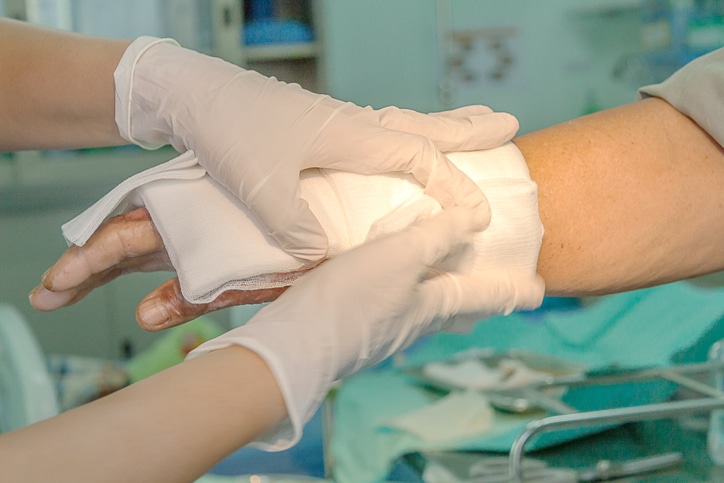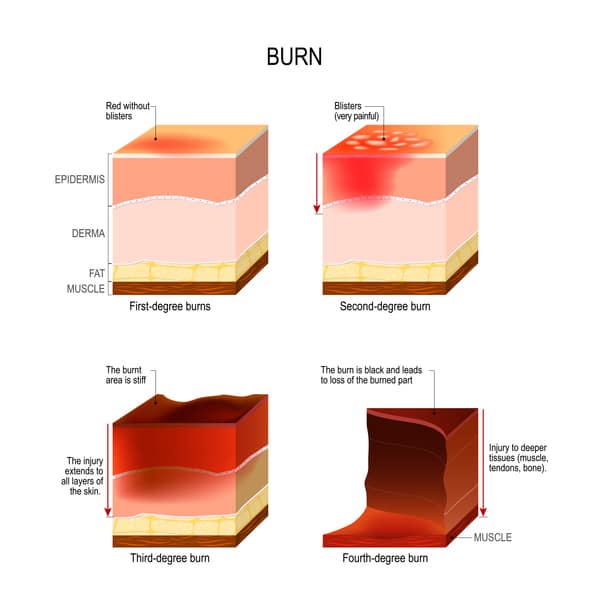As Your Chicago Burn Injury Lawyer, We’re Here to Fight for Your Rights
Fires can destroy lives. Anyone lucky enough to escape such a horror can be left with physical and emotional scars. When a burn comes between you and your best life, what can you do?
If you or a family member suffered burn injuries, you may be entitled to seek compensation. The firm of Shuman Legal® fights fire with fire. Our team members understand the high price burn victims pay. Pain is only the beginning. We fight to get you the highest settlement legally allowed.
Have You Suffered From a Burn Injury? You Need to Watch This…
Discover why our clients have given our firm an average rating of 4.80. Call us to see how we can help you navigate the laws for burn injury victims.
What Are the Five Types of Burn Injuries?
While burns can vary widely, they can be sorted into five main types.
- Chemical. A reaction is caused when harsh substances meet the body. Acid, bleach, ammonia, gasoline, and similar products can cause these caustic burns.
- Electrical. When an electric current comes in direct contact with the body, the result can be painful. Touching exposed home wiring and high-voltage power lines can trigger these burns. Lightning has been listed as a less common source.
- Friction. This type of burn happens when something rubs so roughly against the body it causes the skin to come off. Examples include chafing, rug burn, and rope burn.
- Thermal. Super-hot substances, gases, and objects that touch the skin can cause this kind of burn. Watch out for scalding liquids, fire, heated metal, and fireworks.
- Radiation. Ultraviolet sun rays and X-rays can burn the skin this way. Unfortunately, radiation treatment for cancer can also create this condition.
Note: There’s another type of burn worth mentioning. It may sound strange, but you can get burned from cold. Frostbite is an example of how the skin reacts to freezing temperatures when exposed for too long.
Have you or a loved had a Burn Injury?
Can I Claim Compensation for a Burn at Work?
If you’re injured on the job, you can most likely file a workers’ compensation claim. Most employers are required by law in Illinois to provide employees with workers’ comp insurance. If for some reason you fall outside of this category or your employer had a lapse in coverage, you may seek legal action.
Knowing what to do in this situation can be tricky. All the gray areas make it confusing. No standard rules apply. Every case is different.
You’ve been burned once. Don’t get burned again! You need a Chicago Burn Injury Lawyer! But not just any attorney- the best! Our entire team at Shuman Legal is here for you. We’ll review your case for free and give you our best recommendation. Focus on recovering. Let us handle your burn claim.
What Percentage of Burns Are Considered Severe?
Any burn can feel painful at first. There is a way to assess the severity of a burn. Experts look at the amount of total body surface area (TBSA) affected. According to the U.S. Department of Health and Human Services Chemical Hazards Emergency Medical Management (CHEMM):
- Burn victims with more than 20 to 25 percent of TBSA will need fluid resuscitation
- Burns may be fatal for victims with more than 30 to 40 percent of TBSA who don’t get proper treatment
- Burn victims who are elderly can die from less than 15 percent of TBSA
How Much Does it Cost to Treat a Burn Patient?
Burn injuries are not cheap. Treating an average burn in the U.S. can run $200k-plus. Severe burns may need treatments that run upwards of $1.6 million.
And complications? Well, they can really pile on the greenbacks. Costs associated with disfigurements, scarring, infections, emotional trauma, and skin issues can be staggering. Throw in the need for therapy, dermatological treatments, medications, and skin grafting. Now you’re looking at $10 million or more.
What is the Rule of Nines for Burns?
Emergency medical technicians use this method to quickly assess the extent of burns for someone 14 years or older. The body is divided into sections. Each section is given a percentage value that is either nine percent or a multiple of nine percent.
- Arm and Hand – 9 Percent Each
- Back of the Body – 18 Percent
- Front of the Body – 18 Percent
- Genitalia – 1 Percent
- Head and Neck – 9 Percent
- Legs and Feet – 18 Percent Each
An example would be if someone had one arm and the back of the body burned, a fair estimate would be 27 percent. Knowing this number helps medical professionals determine the best course of treatment.
How do You Tell What Degree Your Burn is?
Every burn can be classified based on the damage it causes. Figuring out what kind of burn you have can help you decide what actions to take.
- First-degree. While painful, these burns are the least dangerous. Sunburn is a common cause. The impacted area may be warm to the touch. Seek medical attention if over-the-counter medicine doesn’t control pain or burn is larger than the palm of your hand.
- Second-degree. Swelling and blisters can reveal the presence of this kind of burn. Pain can be intense. Seek prompt medical attention if the affected area is large and/or connected to important body parts like any part of your face, genitalia, hands, and/or feet.
- Third-degree. These burns are never minor. When skin appears charred, leathery, or white, you may have a third-degree burn. If you hope to prevent permanent tissue damage, get immediate help from a medical professional.
- Fourth-, Fifth- and Sixth-degree. These extreme burns are life-threatening. Immediate medical treatment is critical. Not only are skin layers impacted, but there’s a strong possibility that tissue, muscle, and bone are also. These burns may not be painful because of extensive nerve damage.

Is a Burn an Injury?
Yes! These wounds are common occurrences. Skin becomes inflamed and the tissue may be damaged. Depending on the type of burn and severity level, this injury may even be life-threatening or fatal.
What Happens When You Get a First-degree Burn?
Lucky you! These burns are generally much milder than the other types. Healing from these superficial burns is not the uphill battle you would face with more serious injuries.
Common symptoms include skin peeling away, pain, dryness in the impacted areas, and red-colored skin. While most of these burns can heal on their own, scarring is still possible. It’s important to treat first-degree burns with these steps:
- Sooth the Burn. Run cold water over the wound immediately. Apply cold compresses for a few minutes at a time.
- Take the Sting Out. Once 24 hours have passed, gently apply aloe vera or petroleum jelly a few times a day.
- Pop a Pill. Take mild pain medication such as acetaminophen or ibuprofen. Tablets should improve your comfort level and ease inflammation.
- Protect the Wound. Cover the burn loosely with dry, sterile gauze. Guard against sun exposure once healing is in full swing. Use sunscreen with a minimum of 30 SPF. Seek shady spots.
How Long do Severe Burn Victims Stay in the Hospital?
Every burn case varies. Each victim is different. It’s hard to pinpoint an exact time needed in the hospital for recovery. Complications can add time to your stay.
A general rule of thumb: One day of hospitalization roughly equates to each percent of the body that was burned. An example is if Patient A is being treated for 33 percent of TBSA, he can estimate a hospital stay of around 33 days.
Do Burn Victims Ever Fully Recover?
First-degree burns usually heal over time. Higher-degree burns are different. While miracles are never out of the question, some burns do too much damage for victims to experience a complete recovery. Long after the burn itself has been treated, lingering issues can persist such as:
- Chronic Pain
- Damage to Organs, Muscles, and/or Nerves
- Disfigurement and/or Scars
- Inability to Control Body Temperature
- Increased Risk of Developing Certain Diseases and Conditions
- Persistent Itching
- Psychological Effects Such as Anxiety, Depression, Insomnia, Negative Self-image, Social Isolation, and PTSD
- Temperature Sensitivity
What is the Most Common Cause of Death in Burn Patients?
Although statistics change from year to year, there is one condition that continues to plague severe burn victims- sepsis. This complication appears when bacteria are resistant to antibiotics. A sharp decrease in blood pressure can lead to septic shock. Next comes organ failure. Death may follow.
Burns can cause devastating injuries. Let Shuman Legal be your guide if you or a loved one has suffered this way. When you need a Chicago burn injury lawyer, we’re ready to fight for you! Don’t let your dreams go up in smoke.
If you’re injured on the job, you can most likely file a workers’ compensation claim. Most employers are required by law in Illinois to provide employees with workers’ comp insurance. If for some reason you fall outside of this category or your employer had a lapse in coverage, you may seek legal action.
Knowing what to do in this situation can be tricky. All the gray areas make it confusing. No standard rules apply. Every case is different.
You’ve been burned once. Don’t get burned again! You need a Chicago Burn Injury Lawyer! But not just any attorney- the best! Our entire team at Shuman Legal is here for you. We’ll review your case for free and give you our best recommendation. Focus on recovering. Let us handle your burn claim.
Any burn can feel painful at first. There is a way to assess the severity of a burn. Experts look at the amount of total body surface area (TBSA) affected. According to the U.S. Department of Health and Human Services Chemical Hazards Emergency Medical Management (CHEMM):
- Burn victims with more than 20 to 25 percent of TBSA will need fluid resuscitation
- Burns may be fatal for victims with more than 30 to 40 percent of TBSA who don’t get proper treatment
- Burn victims who are elderly can die from less than 15 percent of TBSA
Burn injuries are not cheap. Treating an average burn in the U.S. can run $200k-plus. Severe burns may need treatments that run upwards of $1.6 million.
And complications? Well, they can really pile on the greenbacks. Costs associated with disfigurements, scarring, infections, emotional trauma, and skin issues can be staggering. Throw in the need for therapy, dermatological treatments, medications, and skin grafting. Now you’re looking at $10 million or more.
Emergency medical technicians use this method to quickly assess the extent of burns for someone 14 years or older. The body is divided into sections. Each section is given a percentage value that is either nine percent or a multiple of nine percent.
- Arm and Hand – 9 Percent Each
- Back of the Body – 18 Percent
- Front of the Body – 18 Percent
- Genitalia – 1 Percent
- Head and Neck – 9 Percent
- Legs and Feet – 18 Percent Each
An example would be if someone had one arm and the back of the body burned, a fair estimate would be 27 percent. Knowing this number helps medical professionals determine the best course of treatment.
Every burn can be classified based on the damage it causes. Figuring out what kind of burn you have can help you decide what actions to take.
- First-degree. While painful, these burns are the least dangerous. Sunburn is a common cause. The impacted area may be warm to the touch. Seek medical attention if over-the-counter medicine doesn’t control pain or burn is larger than the palm of your hand.
- Second-degree. Swelling and blisters can reveal the presence of this kind of burn. Pain can be intense. Seek prompt medical attention if the affected area is large and/or connected to important body parts like any part of your face, genitalia, hands, and/or feet.
- Third-degree. These burns are never minor. When skin appears charred, leathery, or white, you may have a third-degree burn. If you hope to prevent permanent tissue damage, get immediate help from a medical professional.
- Fourth-, Fifth- and Sixth-degree. These extreme burns are life-threatening. Immediate medical treatment is critical. Not only are skin layers impacted, but there’s a strong possibility that tissue, muscle, and bone are also. These burns may not be painful because of extensive nerve damage.
Yes! These wounds are common occurrences. Skin becomes inflamed and the tissue may be damaged. Depending on the type of burn and severity level, this injury may even be life-threatening or fatal.
Lucky you! These burns are generally much milder than the other types. Healing from these superficial burns is not the uphill battle you would face with more serious injuries.
Common symptoms include skin peeling away, pain, dryness in the impacted areas, and red-colored skin. While most of these burns can heal on their own, scarring is still possible. It’s important to treat first-degree burns with these steps:
- Sooth the Burn. Run cold water over the wound immediately. Apply cold compresses for a few minutes at a time.
- Take the Sting Out. Once 24 hours have passed, gently apply aloe vera or petroleum jelly a few times a day.
- Pop a Pill. Take mild pain medication such as acetaminophen or ibuprofen. Tablets should improve your comfort level and ease inflammation.
- Protect the Wound. Cover the burn loosely with dry, sterile gauze. Guard against sun exposure once healing is in full swing. Use sunscreen with a minimum of 30 SPF. Seek shady spots.
Every burn case varies. Each victim is different. It’s hard to pinpoint an exact time needed in the hospital for recovery. Complications can add time to your stay.
A general rule of thumb: One day of hospitalization roughly equates to each percent of the body that was burned. An example is if Patient A is being treated for 33 percent of TBSA, he can estimate a hospital stay of around 33 days.
First-degree burns usually heal over time. Higher-degree burns are different. While miracles are never out of the question, some burns do too much damage for victims to experience a complete recovery. Long after the burn itself has been treated, lingering issues can persist such as:
- Chronic Pain
- Damage to Organs, Muscles, and/or Nerves
- Disfigurement and/or Scars
- Inability to Control Body Temperature
- Increased Risk of Developing Certain Diseases and Conditions
- Persistent Itching
- Psychological Effects Such as Anxiety, Depression, Insomnia, Negative Self-image, Social Isolation, and PTSD
- Temperature Sensitivity
Although statistics change from year to year, there is one condition that continues to plague severe burn victims- sepsis. This complication appears when bacteria are resistant to antibiotics. A sharp decrease in blood pressure can lead to septic shock. Next comes organ failure. Death may follow.
Burns can cause devastating injuries. Let Shuman Legal be your guide if you or a loved one has suffered this way. When you need a Chicago burn injury lawyer, we’re ready to fight for you! Don’t let your dreams go up in smoke.














